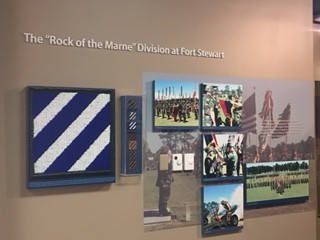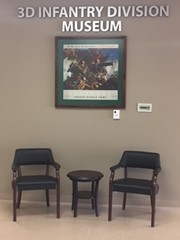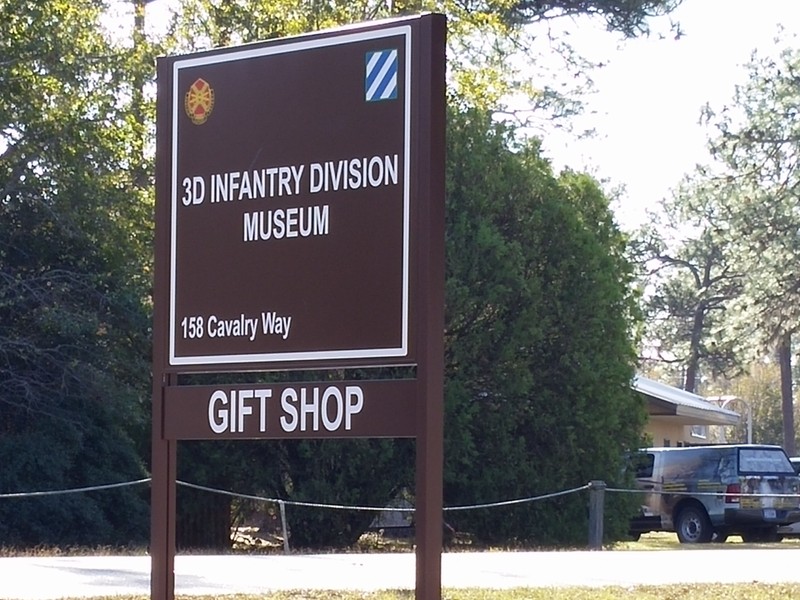Third Infantry Division Museum
Introduction
Text-to-speech Audio
The Third Infantry Division Museum located on Fort Stewart has exhibits ranging from the origins of Camp Stewart to its progression into Fort Stewart. The museum has a variety of portraits showcasing the history of the 3rd Infantry Division from World War I to present day. The museum also features exhibits on Hunter Army Airfield history including the WASPs that were stationed there during World War II. Their online museum features artifacts that archaeologists have found on Fort Stewart and Hunter Army Airfield that date as far back as 11,500 BC. Until recently, the museum was housed in an old wooden building but has now moved to a larger, more modern building that is a safer place for the artifacts to be housed and showcased. Admission is free. Visitors that do not have a military ID card may obtain a visitor's pass from the gate to visit the museum.
Images
3D Infantry Division Museum photo from website: stewart.army.mil.

3D Infantry Division Museum photo from website: stewart.army.mil.

Fort Stewart Museum sign. Photo by Phillip Crandell, Dec. 2016

Backstory and Context
Text-to-speech Audio
The 3rd Infantry Division Museum at Fort Stewart, GA features many different exhibits in its more than 1400 square feet of space that it now has in its new building. The exhibits include not only an interactive gallery that showcases the progression of Camp Stewart to Fort Stewart, but also galleries that present the histories of the 3rd Infantry Division and Hunter Army Airfield. The exhibits also include the histories of the units that have been stationed at Fort Stewart as well as some of the famous soldiers that have served in the 3rd Infantry Division.
The events in Europe in 1939-1940 convinced the United States government that it needed an anti-aircraft training camp and began purchasing land in Georgia for this purpose. In July 1940, the U.S. Government purchased the first 5,000 acres of what was to become Camp Stewart. The Anti-Aircraft Artillery Training Center officially became Camp Stewart in November 1940, though the name was not announced publicly until January 1941. The new camp was named in honor of the Revolutionary War soldier and military hero General Daniel Stewart. The military camp would eventual reach the size of over 280,000 acres.
After the Japanese bombing of Pearl Harbor, new units began to move to the base for training. One of these units was a detachment of Women's Air Service Pilots or WASPs. The WASPs were there to fly planes that towed targets for live fire exercises. This was eventually stopped when radio-controlled airplane targets became available as a safer and more effective way to practice live-fire exercises. As the war progressed more units and soldiers came to Camp Stewart for training. The installation was also used to house German and Italian prisoners of war. After World War II ended, Camp Stewart was reduced to a small group and not increased in manpower until the outbreak of the Korean War.
Camp Stewart became Fort Stewart in 1959 and was re-designated for an Armor and Artillery Firing Center eventually becoming the home of the 3rd Infantry Division. The 3rd Infantry Division has served in World War I, World War II, the Korean War, the Cold War, the Persian Gulf War, and Operation Iraqi Freedom. It has one of the most successful combat records of the U.S. Army, but has lost almost 35,000 soldiers in wars. There have been fifty-five members of the 3rd Infantry Division to be awarded the Medal of Armor while serving their country. One such soldier was Audie Murphy in World War II. Audie Murphy was the most decorated soldier in World War II and the museum has an exhibit in his honor.
The museum is planning to expand in the future to include displays of past military vehicles and expanding exhibits related to the history of the 3rd Infantry Division. They are also planning to expand to include a gallery featuring Airfields and Aviation. The museum website also included links to information on the histories of the 3rd Infantry Division, Fort Stewart, and Hunter Army Airfield. They also have an online museum that showcases artifacts that archaeologists have discovered on the military reservation that date from the Paleoindian Period (11,500-9,500 BC).
The events in Europe in 1939-1940 convinced the United States government that it needed an anti-aircraft training camp and began purchasing land in Georgia for this purpose. In July 1940, the U.S. Government purchased the first 5,000 acres of what was to become Camp Stewart. The Anti-Aircraft Artillery Training Center officially became Camp Stewart in November 1940, though the name was not announced publicly until January 1941. The new camp was named in honor of the Revolutionary War soldier and military hero General Daniel Stewart. The military camp would eventual reach the size of over 280,000 acres.
After the Japanese bombing of Pearl Harbor, new units began to move to the base for training. One of these units was a detachment of Women's Air Service Pilots or WASPs. The WASPs were there to fly planes that towed targets for live fire exercises. This was eventually stopped when radio-controlled airplane targets became available as a safer and more effective way to practice live-fire exercises. As the war progressed more units and soldiers came to Camp Stewart for training. The installation was also used to house German and Italian prisoners of war. After World War II ended, Camp Stewart was reduced to a small group and not increased in manpower until the outbreak of the Korean War.
Camp Stewart became Fort Stewart in 1959 and was re-designated for an Armor and Artillery Firing Center eventually becoming the home of the 3rd Infantry Division. The 3rd Infantry Division has served in World War I, World War II, the Korean War, the Cold War, the Persian Gulf War, and Operation Iraqi Freedom. It has one of the most successful combat records of the U.S. Army, but has lost almost 35,000 soldiers in wars. There have been fifty-five members of the 3rd Infantry Division to be awarded the Medal of Armor while serving their country. One such soldier was Audie Murphy in World War II. Audie Murphy was the most decorated soldier in World War II and the museum has an exhibit in his honor.
The museum is planning to expand in the future to include displays of past military vehicles and expanding exhibits related to the history of the 3rd Infantry Division. They are also planning to expand to include a gallery featuring Airfields and Aviation. The museum website also included links to information on the histories of the 3rd Infantry Division, Fort Stewart, and Hunter Army Airfield. They also have an online museum that showcases artifacts that archaeologists have discovered on the military reservation that date from the Paleoindian Period (11,500-9,500 BC).
Sources
Museum. stewart.army.mil. Last Modified 12/01/2016. Accessed, Feb. 18, 2017. http://www.stewart.army.mil/info/?id=417.
3RD INFANTRY DIVISION (MECHANIZED) History, Symbols and Traditions. warfoto.com. Accessed February 18, 2017. http://www.warfoto.com/3rdsocietyHistory.htm
3RD INFANTRY DIVISION (MECHANIZED) History, Symbols and Traditions. warfoto.com. Accessed February 18, 2017. http://www.warfoto.com/3rdsocietyHistory.htm
Discover the Fort Stewart Military Museum in Hinesville Georgia. N-Georgia.com. Accessed February 19, 2017. http://www.n-georgia.com/fort-stewart-military-museum.html
